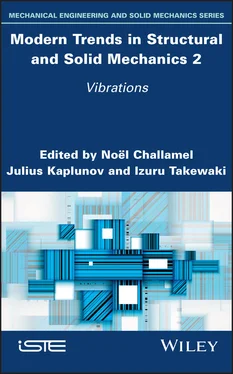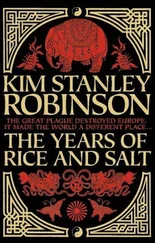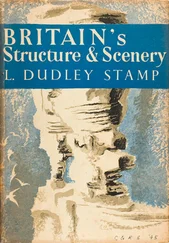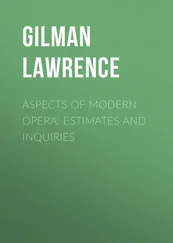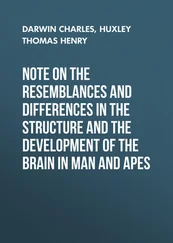1 Cover
2 Title Page Series Editor Noël Challamel
3 Copyright First published 2021 in Great Britain and the United States by ISTE Ltd and John Wiley & Sons, Inc. Apart from any fair dealing for the purposes of research or private study, or criticism or review, as permitted under the Copyright, Designs and Patents Act 1988, this publication may only be reproduced, stored or transmitted, in any form or by any means, with the prior permission in writing of the publishers, or in the case of reprographic reproduction in accordance with the terms and licenses issued by the CLA. Enquiries concerning reproduction outside these terms should be sent to the publishers at the undermentioned address: ISTE Ltd 27-37 St George’s Road London SW19 4EU UK www.iste.co.uk John Wiley & Sons, Inc. 111 River Street Hoboken, NJ 07030 USA www.wiley.com © ISTE Ltd 2021 The rights of Noël Challamel, Julius Kaplunov and Izuru Takewaki to be identified as the authors of this work have been asserted by them in accordance with the Copyright, Designs and Patents Act 1988. Library of Congress Control Number: 2021932076 British Library Cataloguing-in-Publication Data A CIP record for this book is available from the British Library ISBN 978-1-78630-715-6
4 Preface: Short Bibliographical Presentation of Prof. Isaac Elishakoff
5 1 Bolotin’s Dynamic Edge Effect Method Revisited (Review)
1.1. Introduction 1.1. Introduction Professor Isaac E. Elishakoff was a doctoral student of the world-renowned scientist V.V. Bolotin (March 29, 1926 to May 28, 2008) (Bolotin 2006). The first research works of I. Elishakoff and his PhD thesis were devoted to the application and development of the dynamic edge effect (EE) method proposed by V.V. Bolotin. After moving from the Soviet Union to the Western world, Prof. Elishakoff made great efforts to popularize the dynamic EE method in the Western scientific community (Elishakoff 1974, 1976; Elishakoff and Wiener 1976). Therefore, the appearance of a review of papers related to Bolotin’s method in the volume devoted to Prof. Elishakoff’s 75th birthday seems quite reasonable. Moreover, the previous comprehensive reviews of the subject were published in 1976 (Elishakoff 1976) and 1984 (Bolotin 1984). In the early 1960s, V.V. Bolotin put forward an asymptotic method for studying natural oscillations of plates and shells, which used the inverse of the dimensionless vibration frequency as a small parameter (Bolotin 1960a, 1960b). In a more general formulation, it is a method for solving self-adjoint eigenvalue problems defined in a rectangular domain, called the boundary value problems with quasi-separable variables, according to Bolotin’s terminology. For this reason, the method is referred to as Bolotin’s method or the dynamic edge effect method (DEEM). And despite the fact that 60 years have passed since the method creation, it is still relevant. The purpose of this review is describing various generalizations and modifications of DEEM, the problems solved with the use of this method and also trying to determine the place of DEEM among the known methods for finding rapidly oscillating solutions. Thus, we demonstrate that DEEM can be broadly applied for solving modern problems.
1.2. Toy problem: natural beam oscillations 1.3. Linear problems solved 1.4. Generalization for the nonlinear case 1.5. DEEM and variational approaches 1.6. Quasi-separation of variables and normal modes of nonlinear oscillations of continuous systems 1.7. Short-wave (high-frequency) asymptotics. Possible generalizations of DEEM 1.8. Conclusion: DEEM, highly recommended 1.9. Acknowledgments 1.10. Appendix 1.11. References
6 2 On the Principles to Derive Plate Theories2.1. Introduction 2.2. Some historical remarks 2.3. Possibilities to formulate plate theories 2.4. Shear correction 2.5. Conclusion 2.6. References
7 3 A Softening–Hardening Nanomechanics Theory for the Static and Dynamic Analyses of Nanorods and Nanobeams: Doublet Mechanics3.1. Introduction 3.2. Doublet mechanics formulation 3.3. Governing equations 3.4. Analytical solutions 3.5. Numerical results 3.6. Conclusion 3.7. References
8 4 Free Vibration of Micro-Beams and Frameworks Using the Dynamic Stiffness Method and Modified Couple Stress Theory 4.1. Introduction 4.2. Formulation of the potential and kinetic energies 4.3. Derivation of the governing differential equations 4.4. Development of the dynamic stiffness matrix 4.5. Application of the Wittrick–Williams algorithm 4.6. Numerical results and discussion 4.7. Conclusion 4.8. Acknowledgments 4.9. References
9 5 On the Geometric Nonlinearities in the Dynamics of a Planar Timoshenko Beam 5.1. Introduction 5.2. The geometrically exact planar Timoshenko beam 5.3. The asymptotic solution 5.4. The importance of nonlinear terms 5.5. Simplified models 5.6. Conclusion 5.7. References
10 6 Statics, Dynamics, Buckling and Aeroelastic Stability of Planar Cellular Beams6.1. Introduction 6.2. Continuous models of planar cellular structures 6.3. The grid beam 6.4. Buckling 6.5. Dynamics 6.6. Aeroelastic stability 6.7. References
11 7 Collapse Limit of Structures under Impulsive Loading via Double Impulse Input Transformation7.1. Introduction 7.2. Collapse limit corresponding to the critical timing of second impulse 7.3. Classification of collapse patterns in non-critical case 7.4. Analysis of collapse limit using energy balance law 7.5. Verification of proposed collapse limit via time-history response analysis 7.6. Conclusion 7.7. References
12 8 Nonlinear Dynamics and Phenomena in Oscillators with Hysteresis 8.1. Introduction 8.2. Hysteresis model and SDOF response to harmonic excitation 8.3. 2DOF hysteretic systems 8.4. Nonlinear modal interactions in 2DOF hysteretic systems 8.5. Conclusion 8.6. Acknowledgments 8.7. Appendix: Mechanical characteristics of SDOF and 2DOF systems 8.8. References
13 9 Bridging Waves on a Membrane: An Approach to Preserving Wave Patterns 9.1. Introduction 9.2. Problem statement 9.3. Homogenized bridge 9.4. Internal reflections 9.5. Discrete bridge 9.6. Net bridge 9.7. Concluding remarks 9.8. Acknowledgments 9.9. References
14 10 Dynamic Soil Stiffness of Foundations Supported by Layered Half-Space 10.1. Introduction 10.2. Generation of dynamic soil stiffness 10.3. Numerical examples of the generation of dynamic soil stiffness 10.4. Numerical examples of the generation of FRS 10.5. Conclusion 10.6. References
15 List of Authors
16 Index
17 Summary of Volume 1
18 Summary of Volume 3
19 End User License Agreement
1 Preface: Short Bibliographical Presentation of Prof. Isaac Elishakoff Figure P.1. Prof. Isaac Elishakoff Figure P.2. Elishakoff in middle school in the city of Sukhumi, Georgia Figure P.3. Elishakoff just before acceptance to university. Photo taken in Sukh... Figure P.4. Public PhD defense, Moscow Power Engineering Institute and State Uni... Figure P.5. Elishakoff with Bolotin (middle), member of the Russian Academy of S... Figure P.6. Prof. Elishakoff presenting a book to Prof. J. Singer, Technion’s Pr... Figure P.7. Elishakoff having received the William B. Johnson Inter- Professiona... Figure P.8. Inauguration as the Frank Freimann Visiting Professor of Aerospace a... Figure P.9. Prof. Elishakoff with Prof. Warner Tjardus Koiter, Delft University ... Figure P.10. Elishakoff and his colleagues during the AIAA SDM Conference at Pal... Figure P.11. Elishakoff with his wife, Esther Elisha, M.D., during an ASME award...
2 Chapter 1 Figure 1.1. Curve 1 corresponds to the rapidly oscillating solution in the inner...
3 Chapter 3Figure 3.1. Arrangement of atoms in a periodic nanostructure Figure 3.2. Dimensionless displacement of nanorods with dimensionless rod length...Figure 3.3. Frequency parameter of nanorods with rod length for the first three ...Figure 3.4. Frequency parameter of nanorods with mode number. For a color versio...Figure 3.5. Frequency parameters of nanorods with doublet separation distance (η...Figure 3.6. Wave frequency of nanorods with wavenumber. For a color version of t...Figure 3.7. Phase velocity of nanorods with wavenumber. For a color version of t...Figure 3.8. Group velocity of nanorods with wavenumber. For a color version of t...Figure 3.9. Dimensionless displacement of nanobeams with dimensionless beam leng...Figure 3.10. Critical buckling load of nanobeams with beam length. For a color v...Figure 3.11. Frequency parameter of nanobeams with beam length for the first thr...Figure 3.12. Wave frequency of nanobeams with wavenumber Figure 3.13. Phase velocity of nanobeams with wavenumber Figure 3.14. Group velocity of nanobeams with wavenumber
Читать дальше
